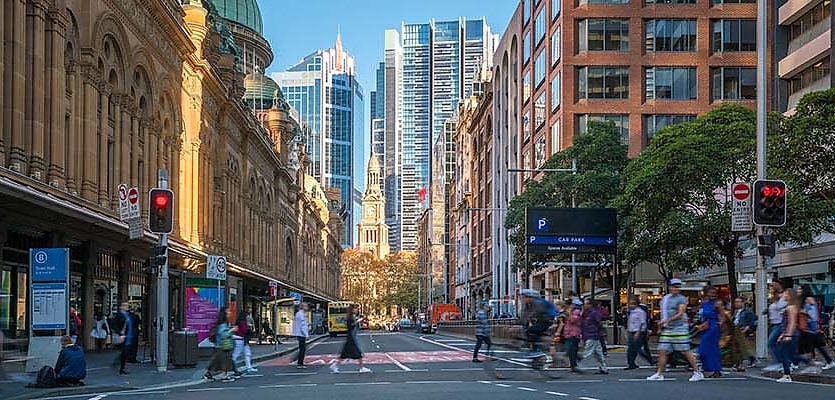As tech continues to change the way consumers go about their daily lives, so too are cities transforming to accommodate their needs.
In practice, this sees the need for some physical spaces and services grow while others recede. A new report from CBRE takes three case studies to show how retail is adjusting along with these shifts.
The commercial real estate firm has looked at how consumer needs and desires have propelled two particular retail markets in Sydney while causing the real estate requirements of one to shift from shop-front to office.
Namely, how beauty stores and bubble tea stores received increased demand, while banks have increasingly moved their customer service to online forms.
CBRE revealed that between the 2017 financial year and 2023 financial year, banks have closed 1,308 – or approximately 39 per cent – of branches across the country. What they are focusing on instead is ensuring that almost all personal banking activities can be completed on a device, while ensuring that they still retain a physical presence in high-traffic areas, so they can cater to more complex financial activities that require face-to-face consultation.
The number of ATMs in major cities has also decreased by 62 per cent in the past seven years, showing that business shifts in banking have also resulted in the replacement of old tech with the new.
The retail space that banks are maintaining, however, are increasingly styled as hub-like all-service spaces, with a focus on being able to cater to all customer needs – not minimally staffed offshoots where personnel may not be able to handle certain transactions.
CBRE head of retail research Amita Mehra explained that many of the top Australian banks are focusing on larger and more centrally located branches, leasing of flagship style floorspace on Sydney’s major strips.
As a result, she said: “This consolidation has freed up sought-after city floorspace and created opportunities for retailers to obtain prime retail leases.”
Two of the subsectors taking advantage of this free commercial space are beauty shops and bubble tea stores.
The Australian beauty industry has seen steady growth over the past decade. Total cosmetics revenue rose from $4.3 billion in the 2011 financial year to 5.3 billion in 2023. By the 2028 financial year, the sector is expected to be worth $5.9 billion.
E-commerce has contributed substantially to this, however, beauty has managed to retain a necessity for the in-store experience in ways that other retail operators have not.
As CBRE found, 46 per cent of cosmetics shoppers still report that they test and colour-match products in physical stores before buying. With beauty products subject to a different return policy than other items such as clothing or accessories, shoppers are less likely to “take the bet” on an online purchase without having tested or used the product before.
“In-person sampling, consultations and personalised services remain integral to the customer journey. Beauty brands therefore necessitate a strategically integrated omni-channel approach spanning experiential brick-and-mortar stores and e-commerce. The in-store element stays vital even as virtual experiences advance,” CBRE explained.
A case study looking at the growth and shifting footprint of Australian retailer Mecca showed how this played out in Sydney’s central business district (CBD).
Despite being the largest player in the Australian beauty industry with 16 per cent of market share, it reportedly captures 6 per cent of online cosmetics sales.
With a regional footprint four times larger than that of other major player Sephora, the brand is set on further increasing its physical presence.
Mecca’s George Street store in Sydney’s CBD is the largest beauty retail store in the Southern Hemisphere. The brand has stated that it intends to grow its physical footprint of 108 stores across ANZ by 70 per cent over the next three years, with high confidence that consumer demand will meet this growth.
The bubble tea market, meanwhile, has certainly shown how a sector can scale rapidly to meet growing demand.
And CBRE anticipates that further expansion of the niche sector will continue to succeed, with shifting demographics a primary driver of expected continued success.
“Sydney is forecast to add 1.02 million residents by 2032, largely driven by migration from Asian countries where bubble tea is highly popular. This incoming demographic will continue to fuel bubble tea demand, allowing new stores to succeed even in areas with an existing bubble tea presence,” the firm explained.
CBRE’s research forecasted a steady 4.5 per cent revenue growth in Sydney’s bubble tea market between 2024 and 2029. By that time, who knows what other retailers will be surging ahead or reassessing their spatial needs with the face of the city’s retail ever evolving.
ABOUT THE AUTHOR
Juliet Helmke
Based in Sydney, Juliet Helmke has a broad range of reporting and editorial experience across the areas of business, technology, entertainment and the arts. She was formerly Senior Editor at The New York Observer.

Never miss a beat with
Stay across what’s happening in the Australian commercial property market by signing up to receive industry-specific news and policy alerts, agency updates, and insights from reb.
Subscribe to reb Commercial:







You are not authorised to post comments.
Comments will undergo moderation before they get published.